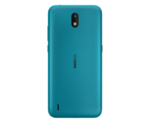Nokia 1.3
Specifications

Secondary Camera: 5 MPix
Price comparison
Average of 8 scores (from 12 reviews)
Reviews for the Nokia 1.3
The Nokia 1.3 is supposed to convince as a cheap smartphone especially by the price. With a replaceable battery and face recognition for unlocking it would have good beginnings, but it doesn't exactly make everyday life easy for its user due to detail errors.
Source: Tech Advisor
 Archive.org version
Archive.org versionThe Nokia 1.3 might look like a bargain at first glance and even in the hand, but there's little point getting a phone that suffers from such painful performance issues.
Single Review, online available, Long, Date: 07/22/2020
Rating: Total score: 60%
Source: 9to5google
 Archive.org version
Archive.org versionSingle Review, online available, Long, Date: 06/30/2020
Source: Ausdroid
 Archive.org version
Archive.org versionHMD's Nokia 1.3 is an affordable smartphone powered by Android Go, and while it won't set the world alight with its performance, it's a capable entry-level phone for the casual mobile user.
Single Review, online available, Medium, Date: 06/15/2020
Rating: Total score: 78% mobility: 80% workmanship: 80%
Source: T3
 Archive.org version
Archive.org versionMost aspects of the Nokia 1.3 remind you that this is a very affordable phone – the performance, the design, the camera quality – but as long as you're sticking to the basics, it's a cost vs benefits balance that we think will appeal to a certain number of people.
Single Review, online available, Long, Date: 06/08/2020
Rating: Total score: 80%
Foreign Reviews
Source: Tech Stage
 DE→EN Archive.org version
DE→EN Archive.org versionSingle Review, online available, Long, Date: 06/02/2020
Source: Futurezone.at
 DE→EN Archive.org version
DE→EN Archive.org versionSingle Review, online available, Long, Date: 05/05/2020
Source: Android Pit
 DE→EN Archive.org version
DE→EN Archive.org versionSingle Review, online available, Medium, Date: 04/26/2020
Rating: Total score: 60%
Source: Inside Handy
 DE→EN Archive.org version
DE→EN Archive.org versionSingle Review, online available, Medium, Date: 04/19/2020
Source: Tech Stage
 DE→EN Archive.org version
DE→EN Archive.org versionSingle Review, online available, Long, Date: 04/17/2020
Source: Computer Totaal
 NL→EN Archive.org version
NL→EN Archive.org versionSingle Review, online available, Short, Date: 06/18/2020
Rating: Total score: 80%
Source: AndroidPit.fr
 FR→EN Archive.org version
FR→EN Archive.org versionSingle Review, online available, Long, Date: 04/27/2020
Rating: Total score: 60%
Source: Arena IT
 →EN Archive.org version
→EN Archive.org versionSingle Review, online available, Long, Date: 11/03/2020
Rating: Total score: 70% price: 100% features: 60% mobility: 50% workmanship: 70%
Comment
Model:
HMD Global has released two new affordable phones recently as part of its Nokia range. The two mentioned are the Nokia 5.3 and the Nokia 1.3. The Nokia 1.3 is one of the most affordable smartphones from its company. It runs Android Go software, a pared down version of Android 10 that has been designed specifically for smartphones with lower specifications. In terms of its display, this model has been equipped with a 5.71-inch display with a 1520 x 720 resolution. It is an IPS screen with a U-shaped notch overhead. While the Nokia 1.3 is a Snapdragon-running smartphone, it is highly notable that it does not have one of the high-end Snapdragon CPUs but rather a lower-end Qualcomm SD 215. This processor is obviously capable of handling day-to-day usage.
The processor has been coupled with an Adreno 308 GPU, 1 GB of RAM and 16 GB of storage which is expandable by up to 128GB through a dedicated SD card. The Adreno 308 definitely has a slight edge, because it technically has the highest clocking of the entry-level Adreno 300 series, but the performance will still be on similar ground as the 300 series GPUs, since the architecture is similar. Therefore, highly demanding Android games might not run completely smoothly with the Adreno 308, but simple titles like Angry Bird and the usual multimedia tasks are definitely not a problem. As for the battery, the Nokia 1.3 has been incorporated with a 3,000mAh battery with 5W fast-charging support. This definitely reduces the time needed for recharging the phone. In addition, HMD Global claims that the phone will last for a whole day on a single charge, which is definitely something to note.
Apart from that, this smartphone has replaced the fingerprint scanner with FaceID for unlocking the phone with a face-recognition system. It also comes with dual SIMs with 4G LTE network. As far as the camera is concerned, the Nokia 1.3 has incorporated a single 8-megapixel main camera with Phase Detection Autofocus (PDAF), a single LED flash and an f/2.0 aperture. PDAF is actually an image-processing technology that takes account of two different images whenever an image is about to be captured. The image processor will automatically adjust the camera lenses to phase the images until it synchronizes them, creating the best possible image between the two. There is also a wide-angle 5-megapixel camera for selfies and video chats that resides within the notch upfront. As for the choices available, the Nokia 1.3 has been introduced in three color variants, namely Cyan, Charcoal and Sand, for users to choose from based on individual preferences. While the phone is definitely a decent bet for its price, the choice of owning one is obviously rather subjective, depending on the individual budget, preference and overall need.
Hands-on article by Jagadisa Rajarathnam
Qualcomm Adreno 308: Integrated mid-range graphics card in the Snapdragon 425 SoCs that supports OpenGL ES 3.0 and features unified shaders.
These graphics cards are not suited for Windows 3D games. Office and Internet surfing however is possible.
» Further information can be found in our Comparison of Mobile Graphics Cards and the corresponding Benchmark List.
SD 215: 64-Bit Cortex-A53 Quad-Core with an Adreno 306 GPU manufactured in 28nm. The APQ parts lack the integrated cellular radio (3G, 4G).» Further information can be found in our Comparison of Mobile Processsors.



